A sauté pan is not just a kitchen tool; it’s a culinary magic wand that transforms ordinary ingredients into extraordinary dishes with a flick of the wrist.
Picture this: sizzling aromas wafting through the air, vibrant colors dancing in the pan, and flavors melding together in a symphony of taste.
It’s the versatile workhorse of professional chefs and home cooks alike, bridging the gap between searing, simmering, and sautéing with effortless grace.
From crispy vegetables to succulent meats, a sauté pan is the secret weapon in every cook’s arsenal, unlocking a world of culinary possibilities with each sizzle and stir.
So, buckle up and prepare to embark on a flavorful journey as we delve into the captivating realm of the sauté pan.
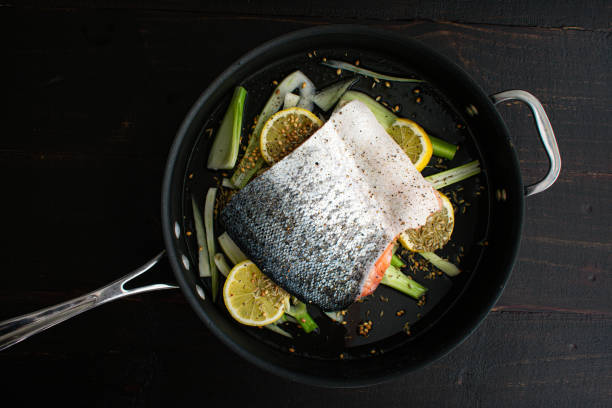
What Is A Saute pan
A sauté pan, also known as a sauté skillet or frying pan, is a versatile kitchen essential designed for cooking techniques like sautéing, frying, searing, and braising.
It features a wide, flat bottom with low sides that slope gently upward, allowing for easy stirring and flipping of ingredients.
The term “sauté” itself refers to the cooking method of quickly frying food in a small amount of oil or fat over medium to high heat, often used for vegetables, meats, and seafood.
This type of pan typically comes with a long handle for comfortable grip and maneuverability while cooking.
It’s a favorite among chefs and home cooks alike due to its ability to evenly distribute heat and facilitate quick cooking without excessive oil or fat.
When discussing sauté pans, people often mention their non-stick properties, which make cooking and cleaning a breeze.
They’re also praised for their durability, often made from materials like stainless steel, aluminum, or copper, sometimes coated with a non-stick surface like ceramic or Teflon.
The size of a sauté pan varies, with options ranging from small pans suitable for single servings to larger ones perfect for family meals.
Its versatility extends beyond sautéing, as it can be used for tasks like shallow frying, making sauces, and even baking certain dishes in the oven. In professional kitchens, sauté pans are essential tools, showcasing their importance in culinary endeavors and everyday cooking adventures.
What Is a Saute Pan Used For?
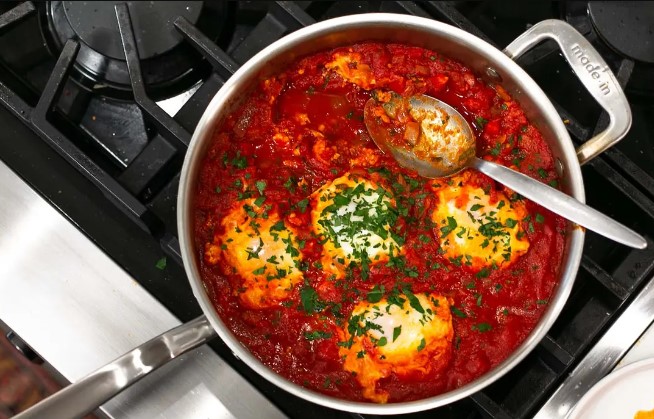
A sauté pan is a versatile kitchen tool used for various cooking techniques, making it a staple in many kitchens. Here’s what a sauté pan is used for:
- Sautéing: The primary purpose of a sauté pan is for sautéing, a cooking method that involves quickly cooking food over medium to high heat in a small amount of oil or fat. This technique is commonly used for vegetables, meats, seafood, and poultry, allowing them to retain their natural flavors and textures while developing a delicious caramelized exterior.
- Frying: Sauté pans can also be used for shallow frying or pan-frying food items like chicken cutlets, fish fillets, or breaded vegetables. The wide, flat base of the pan provides ample space for even cooking and browning.
- Braising: While not as deep as a traditional braising pan, a sauté pan with a lid can be used for braising smaller cuts of meat or vegetables. Braising involves cooking food slowly in a small amount of liquid, resulting in tender and flavorful dishes.
- Simmering and Reductions: The wide surface area of a sauté pan is ideal for simmering sauces, reducing liquids, or making pan sauces after searing meats. This allows for faster evaporation and concentration of flavors.
- Stir-Frying: Although not as common as using a wok for stir-frying, a sauté pan can be used for stir-frying smaller batches of ingredients, especially when a wok is not available. The sloped sides of the pan make it easier to toss and stir ingredients quickly.
- Searing: Sauté pans are suitable for searing meats before finishing them in the oven or continuing with other cooking methods. The wide cooking surface helps achieve a good sear without overcrowding the pan.
- Multi-Purpose Cooking: Apart from these specific uses, sauté pans are also handy for preparing one-pan meals, reheating leftovers, toasting nuts or spices, and even baking certain dishes in the oven, thanks to their oven-safe construction.
In summary, a sauté pan is a versatile tool that can handle a wide range of cooking techniques, making it an essential item for home cooks and professional chefs alike.
How to Use a Saute Pan?
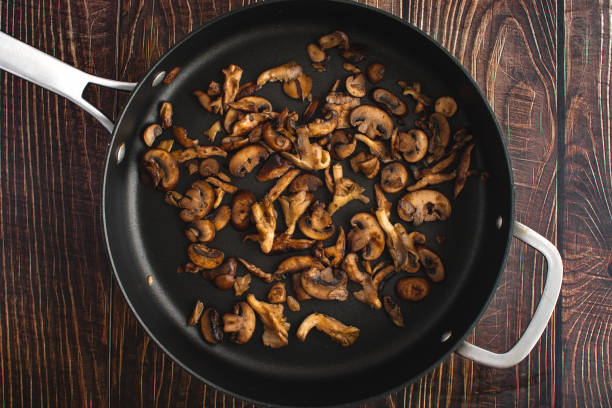
Using a sauté pan effectively involves a few key steps and techniques to ensure delicious and well-cooked dishes. Here’s a guide on how to use a sauté pan:
Preparation
- Select the appropriate size sauté pan for your recipe, considering the amount of food you’ll be cooking. A pan that’s too small can lead to overcrowding and uneven cooking.
- Place the sauté pan on the stovetop and preheat it over medium to medium-high heat. Allow the pan to heat evenly before adding any oil or ingredients.
Add Oil or Fat
- Once the pan is hot, add a small amount of oil or fat with a high smoke point, such as olive oil, vegetable oil, or clarified butter. Swirl the oil around the pan to coat the bottom evenly.
Sautéing
- Add the ingredients you want to sauté to the pan. For vegetables, ensure they are cut into uniform pieces for even cooking. For meats or seafood, pat them dry with paper towels to promote browning.
- Use a spatula or tongs to move the ingredients around the pan continuously. This helps them cook evenly and prevents sticking.
- Season the ingredients with salt, pepper, and any other desired herbs or spices during the cooking process.
Adjust Heat as Needed
- Monitor the heat throughout the cooking process. If the ingredients are browning too quickly or the oil is smoking excessively, reduce the heat slightly.
- Conversely, if the ingredients are not browning enough or seem to be steaming rather than sautéing, increase the heat slightly.
Searing
- If you’re searing meats or seafood, ensure the pan is hot enough to achieve a good sear. Place the protein in the pan, making sure not to overcrowd it. Allow it to sear without moving it too much to develop a caramelized crust.
- Flip the protein once it has a golden-brown sear on one side and continue cooking until done to your desired level of doneness.
Deglazing and Making Pan Sauces
- After sautéing or searing, you can deglaze the pan to create flavorful pan sauces. Add a liquid like broth, wine, or vinegar to the hot pan and use a spatula to scrape up any browned bits (fond) from the bottom of the pan. Simmer the liquid until it reduces and thickens into a sauce.
Serve or Continue Cooking
- Once your ingredients are cooked to perfection, remove them from the pan and serve immediately.
- Alternatively, you can use the sauté pan for additional cooking techniques, such as braising, simmering, or finishing dishes in the oven, depending on your recipe.
Cleaning
- After use, allow the sauté pan to cool slightly before washing it with warm, soapy water.
- Avoid using abrasive sponges or harsh cleaners that could damage the pan’s surface.
By following these steps and techniques, you can make the most of your sauté pan and create flavorful, well-cooked dishes with ease.
How Does a Saute Pan Differ From Other Pans?
A sauté pan differs from other types of pans primarily in its design, purpose, and cooking techniques. Here are the key differences between a sauté pan and other pans like frying pans, saucepans, and stockpots:
Saute Pan vs. Frying Pans
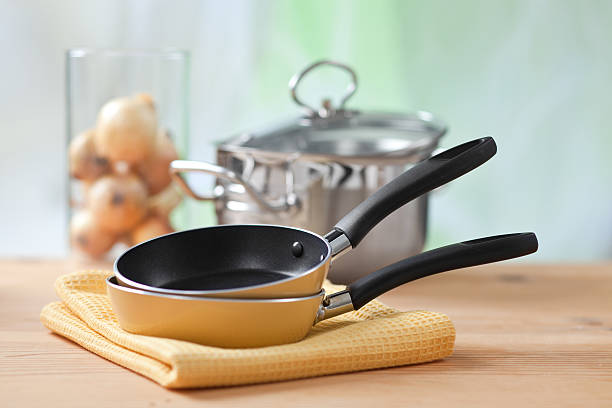
When comparing a sauté pan and a frying pan (also known as a skillet), there are several key differences in their design, purpose, and functionality. Here’s a breakdown of how they differ:
Design and Shape
- Sauté Pan: A sauté pan typically has straight or slightly sloped sides and a wide, flat cooking surface. It often comes with a lid and may have a helper handle opposite the main handle for easier lifting.
- Frying Pan (Skillet): A frying pan or skillet has low, sloping sides and a flat bottom. It is designed for cooking foods quickly over high heat, allowing for easy tossing and flipping of ingredients.
Purpose and Cooking Techniques
- Sauté Pan: A sauté pan is versatile and suitable for a wide range of cooking techniques, including sautéing, shallow frying, braising, searing, simmering, and making pan sauces. Its depth and wide surface area make it ideal for cooking larger quantities of food evenly without overcrowding.
- Frying Pan (Skillet): A frying pan is specifically designed for frying, searing, and browning foods quickly over high heat. It excels at achieving crispy textures and caramelization on foods like meats, vegetables, and eggs.
Versatility
- Sauté Pan: Due to its versatility, a sauté pan can handle various cooking tasks beyond just frying. It can be used for braising meats, simmering sauces, making pan sauces, and even cooking one-pan meals.
- Frying Pan (Skillet): While primarily used for frying and searing, a frying pan can also handle tasks like sautéing vegetables, cooking pancakes or crepes, and even baking certain dishes in the oven.
Size and Capacity
- Sauté Pan: Sauté pans come in various sizes, but they are generally deeper than frying pans to accommodate cooking liquids and larger ingredients.
- Frying Pan (Skillet): Frying pans are typically shallower than sauté pans, allowing for easier access when flipping or stirring foods.
Usage Recommendations
- Sauté Pan: Use a sauté pan when you need to cook larger quantities of food, want to retain moisture in the dish, or require a pan suitable for a variety of cooking techniques.
- Frying Pan (Skillet): Use a frying pan when you want to quickly fry or sear foods, achieve crispy textures, or cook smaller portions that don’t require as much liquid.
Concisely, while both sauté pans and frying pans have their unique uses and strengths, the choice between them depends on the specific cooking task at hand. A sauté pan offers versatility and depth for various cooking techniques, while a frying pan excels at quick frying, searing, and achieving crispy results.
Saute Pan vs. Saucepan
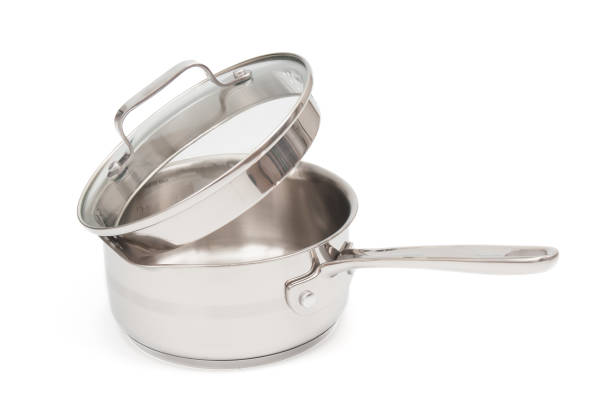
When comparing a sauté pan and a saucepan, there are several distinct differences in their design, purpose, and functionality. Here’s how they differ:
Design and Shape
- Sauté Pan: A sauté pan features straight or slightly sloped sides and a wide, flat cooking surface. It is often deeper than a frying pan but shallower than a saucepan.
- Saucepan: A saucepan has taller, straight sides and a smaller cooking surface compared to a sauté pan. It is designed primarily for cooking liquids, sauces, and smaller batches of food.
Purpose and Cooking Techniques
- Sauté Pan: A sauté pan is versatile and suitable for various cooking techniques, including sautéing, shallow frying, braising, searing, simmering, and making pan sauces. Its wide surface area and depth make it ideal for cooking larger quantities of food evenly.
- Saucepan: A saucepan is specifically designed for cooking liquids, sauces, soups, and smaller portions of food. It is suitable for boiling, simmering, reheating, and making sauces that require consistent stirring.
Versatility
- Sauté Pan: Due to its versatility, a sauté pan can handle a wide range of cooking tasks beyond just sautéing. It is also suitable for braising meats, simmering sauces, making pan sauces, and cooking one-pan meals.
- Saucepan: A saucepan is primarily used for cooking liquids and sauces but can also be used for boiling pasta or grains, simmering soups, and reheating leftovers.
Size and Capacity
- Sauté Pan: Sauté pans come in various sizes, but they are generally deeper and have a larger capacity than saucepans to accommodate cooking liquids and larger ingredients.
- Saucepan: Saucepans are typically smaller in size with capacities ranging from 1 to 4 quarts, making them suitable for cooking smaller batches of food and liquids.
Usage Recommendations
- Sauté Pan: Use a sauté pan when you need to cook larger quantities of food, want to retain moisture in the dish, or require a versatile pan for various cooking techniques.
- Saucepan: Use a saucepan when cooking liquids, making sauces, reheating leftovers, boiling small batches of pasta or grains, or simmering soups and stews.
Concisely, while both sauté pans and saucepans are essential kitchen tools, they serve different purposes based on the type of cooking you’re doing. A sauté pan offers versatility and depth for a wide range of cooking techniques, while a saucepan is specialized for cooking liquids, sauces, and smaller portions of food.
Saute Pan vs. Wok
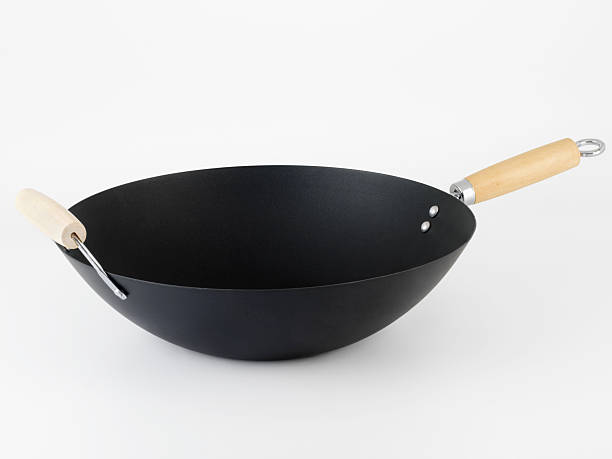
When comparing a sauté pan and a wok, there are several key differences in their design, purpose, and cooking techniques. Here’s how they differ:
Design and Shape
- Sauté Pan: A sauté pan typically has straight or slightly sloped sides and a wide, flat cooking surface. It often comes with a lid and may have a helper handle for easier lifting.
- Wok: A wok has a unique design with deep, sloping sides that curve upwards. It has a rounded bottom that allows for heat to be distributed evenly across the cooking surface.
Purpose and Cooking Techniques
- Sauté Pan: A sauté pan is versatile and suitable for various cooking techniques, including sautéing, shallow frying, braising, searing, simmering, and making pan sauces. It is ideal for cooking larger quantities of food evenly without overcrowding.
- Wok: A wok is specifically designed for stir-frying, a cooking technique that involves quick cooking over high heat while constantly tossing and stirring ingredients. It is also suitable for deep-frying, steaming, braising, and even smoking foods.
Versatility
- Sauté Pan: Due to its versatility, a sauté pan can handle a wide range of cooking tasks beyond just sautéing. It can be used for braising meats, simmering sauces, making pan sauces, and cooking one-pan meals.
- Wok: While primarily used for stir-frying, a wok’s versatility extends to other cooking techniques such as deep-frying, steaming (with a steaming rack), braising (using a lid), and even smoking foods (with wood chips).
Size and Capacity
- Sauté Pan: Sauté pans come in various sizes, but they are generally deeper and have a larger capacity than woks to accommodate cooking liquids and larger ingredients.
- Wok: Woks are available in different sizes, with traditional woks being larger and deeper than sauté pans. The depth and shape of a wok allow for efficient stir-frying and tossing of ingredients.
Heat Distribution
- Sauté Pan: Sauté pans typically have a thick, flat bottom that promotes even heat distribution across the cooking surface. This is ideal for searing and browning ingredients evenly.
- Wok: Woks are designed to distribute heat evenly across the entire cooking surface, with the highest heat concentrated at the bottom and gradually decreasing towards the sides. This helps in quick cooking and maintaining the integrity of ingredients.
Cooking Surface
- Sauté Pan: The flat cooking surface of a sauté pan is suitable for cooking a wide range of ingredients, including meats, vegetables, and sauces.
- Wok: The rounded bottom and sloping sides of a wok make it ideal for tossing and stirring ingredients continuously during stir-frying, ensuring even cooking and flavor development.
Concisely, while both sauté pans and woks are valuable kitchen tools, they serve different purposes based on the cooking techniques and dishes you want to prepare. A sauté pan offers versatility and depth for various cooking techniques, while a wok excels at stir-frying and is versatile enough to handle other cooking methods like deep-frying, steaming, and braising.
Saute Pan vs. Sauteuse
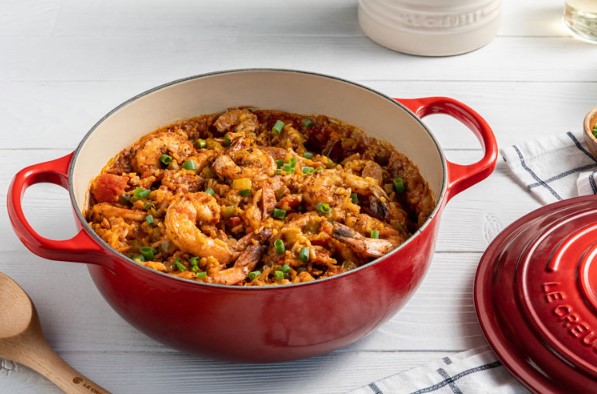
A sauté pan and a sauteuse (also known as a saucier pan) are both versatile cooking tools, but they have distinct differences in design, purpose, and functionality. Here’s how they compare:
Design and Shape
- Sauté Pan: A sauté pan typically has straight or slightly sloped sides and a wide, flat cooking surface. It often comes with a lid and may have a helper handle for easier lifting.
- Sauteuse (Saucier Pan): A sauteuse or saucier pan has rounded, sloping sides that meet the base of the pan at a sharp angle. This design makes it easier to stir and whisk sauces without corners where ingredients can get stuck.
Purpose and Cooking Techniques
- Sauté Pan: A sauté pan is versatile and suitable for various cooking techniques, including sautéing, shallow frying, braising, searing, simmering, and making pan sauces. Its wide surface area and depth make it ideal for cooking larger quantities of food evenly.
- Sauteuse (Saucier Pan): A sauteuse pan is specifically designed for making sauces, custards, and delicate dishes that require constant stirring or whisking. The rounded sides and wider base allow for even heating and easy incorporation of ingredients.
Versatility
- Sauté Pan: Due to its versatility, a sauté pan can handle a wide range of cooking tasks beyond just sautéing. It can be used for braising meats, simmering sauces, making pan sauces, and cooking one-pan meals.
- Sauteuse (Saucier Pan): A sauteuse pan is primarily used for sauce-making and delicate cooking tasks that require precise temperature control and frequent stirring or whisking.
Size and Capacity
- Sauté Pan: Sauté pans come in various sizes, but they are generally deeper and have a larger capacity than sauteuse pans to accommodate cooking liquids and larger ingredients.
- Sauteuse (Saucier Pan): Sauteuse pans are typically shallower with rounded sides, allowing for efficient stirring and whisking of sauces without ingredients getting trapped in corners.
Heat Distribution
- Sauté Pan: Sauté pans typically have a thick, flat bottom that promotes even heat distribution across the cooking surface. This is ideal for searing and browning ingredients evenly.
- Sauteuse (Saucier Pan): Sauteuse pans are designed to distribute heat evenly across the entire cooking surface, including the rounded sides, ensuring that sauces and delicate dishes cook uniformly without hot spots.
Concisely, while both sauté pans and sauteuse (saucier) pans are valuable in the kitchen, they serve different purposes based on the type of cooking techniques and dishes you want to prepare.
A sauté pan offers versatility for a wide range of cooking tasks, while a sauteuse pan is specialized for making sauces, custards, and delicate dishes that require constant stirring or whisking.
Do I Need a Saute Pan?
Whether or not you need a sauté pan depends on your cooking habits, the types of dishes you prepare frequently, and your overall kitchen setup. Here are some factors to consider when deciding if a sauté pan is a necessary addition to your cookware collection:
- Versatility: Sauté pans are incredibly versatile and can handle a wide range of cooking techniques, including sautéing, shallow frying, braising, searing, simmering, and making pan sauces. If you often cook dishes that require these techniques or prefer a multi-purpose pan that can handle various cooking tasks, a sauté pan can be a valuable addition to your kitchen.
- Cooking Capacity: Sauté pans are typically deeper than frying pans and have a larger cooking capacity, making them suitable for cooking larger quantities of food evenly without overcrowding the pan. If you frequently cook for a family or enjoy preparing one-pan meals with multiple ingredients, a sauté pan’s size and depth can be beneficial.
- Cooking Surface: The wide, flat cooking surface of a sauté pan allows for even heat distribution and proper browning of ingredients. This is especially useful for searing meats, sautéing vegetables, and simmering sauces. If you find yourself needing a pan with ample cooking space and consistent heat distribution, a sauté pan can meet these requirements.
- Recipe Requirements: Consider the types of recipes you frequently cook or would like to try. Many recipes specify using a sauté pan for certain cooking techniques or dishes. If you often come across recipes that recommend using a sauté pan and want to achieve optimal results, having one in your kitchen can be advantageous.
- Kitchen Space: Evaluate your kitchen space and storage options. Sauté pans, especially larger ones, may require more storage space compared to smaller pans. If you have limited cabinet or storage space, prioritize cookware that you use frequently or that serves multiple purposes.
Concisely, while a sauté pan offers versatility and functionality for various cooking techniques, whether you need one depends on your cooking preferences, the types of dishes you prepare, and your available kitchen space.
If you frequently use cooking methods like sautéing, shallow frying, braising, and making pan sauces, investing in a sauté pan can enhance your culinary capabilities.
However, if you primarily use other types of pans for your cooking needs and don’t require the specific features of a sauté pan, it may not be essential for your kitchen setup.
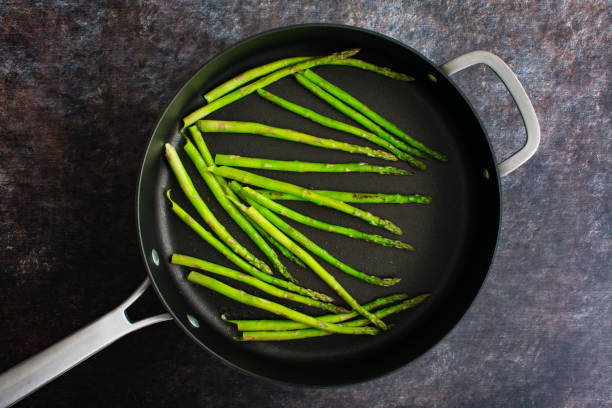
Frequently Asked Questions (FAQs) – What Is A Saute pan
Q: What makes a sauté pan a versatile kitchen essential?
A: A sauté pan is a versatile kitchen essential due to its wide, flat cooking surface and tall, straight sides, allowing for easy stirring, tossing, and flipping of ingredients while preventing spills.
Q: How does a sauté pan differ from other types of cookware?
A: Unlike other cookware, a sauté pan is specifically designed for sautéing, frying, braising, searing, and simmering foods. Its design helps in retaining moisture and flavors while cooking.
Q: What are the benefits of using a sauté pan for cooking?
A: The benefits of using a sauté pan include even heat distribution, efficient cooking, versatility in cooking techniques, and the ability to handle a variety of ingredients from vegetables to meats.
Q: How does the design of a sauté pan enhance cooking performance?
A: The design of a sauté pan, with its wide base and straight sides, promotes efficient heat transfer and uniform cooking, ensuring that food is evenly cooked without hot spots.
Q: What cooking techniques can be used with a sauté pan?
A: Cooking techniques that can be used with a sauté pan include sautéing, frying, braising, searing, and simmering. Its versatility makes it suitable for a wide range of recipes and cooking styles.
Q: How does a sauté pan promote even heat distribution for optimal cooking results?
A: A sauté pan’s construction, often with materials like stainless steel or non-stick coatings, facilitates even heat distribution across the cooking surface, ensuring consistent and thorough cooking of ingredients.
Q: What makes a sauté pan easy to clean and maintain?
A: Cleaning and maintaining a sauté pan is easy due to its smooth cooking surface and often dishwasher-safe materials, making it a convenient choice for everyday cooking.
Q: How can a sauté pan elevate the flavors and textures of dishes?
A: A sauté pan’s design and even heat distribution enhance the flavors and textures of dishes by allowing ingredients to cook evenly and develop complex flavors.
Q: What are some innovative ways to use a sauté pan beyond traditional sautéing?
A: Beyond traditional sautéing, a sauté pan can be used for making sauces, frying foods, braising meats, and even baking certain dishes, showcasing its versatility in the kitchen.
Q: How does the material of a sauté pan impact its functionality and durability?
A: The material of a sauté pan, such as stainless steel, aluminum, or ceramic, impacts its functionality and durability, with each material offering unique benefits in terms of heat conductivity, non-stick properties, and longevity.
Conclusion
In conclusion, a sauté pan is a versatile and essential tool in the kitchen, designed for cooking techniques like sautéing, frying, and simmering.
Its wide, flat base and tall, straight sides provide ample space for ingredients to cook evenly and retain moisture. With its sturdy construction and heat-conducting properties, a sauté pan is perfect for a wide range of recipes, from stir-fries and sauces to one-pan meals.
Whether you’re a professional chef or a home cook, investing in a high-quality sauté pan can elevate your culinary skills and enhance your cooking experience.
Other Articles You May Also Like:
- What Is A Saucepan (7 Things You Should Know)
- What Is Grill Pan (4 Surprising Facts)
- Is Pan Frying Healthy (8 Helpful Reasons)
- What Is Pan Frying (5 Helpful Things To Know)
- What Can You Cook In Stainless Steel Pans (5 Things You Should Know)
- Can Stainless Steel Pans Go In The Oven (7 Cool Ways)
- How Long Do Non Stick Pans Last (3 Eye-opening Things To know)